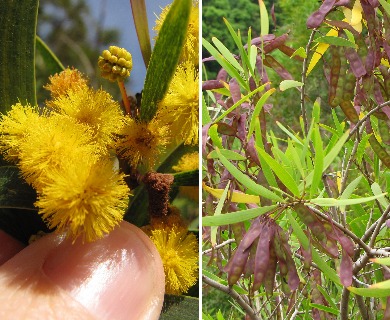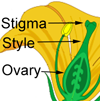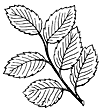Small Philippine Acacia
Acacia confusa
Pea family (Fabaceae)
Post-Cook introduction
Handsome spreading tree, introduced for ornament and forest planting, with compact rounded curved or sickle-shaped leaves, like koa, flowers in small light yellow balls, and narrow flat dark brown pods not smaller between seeds. A tree 20–50 ft (6–15 ) tall, with one or more forking trunks to 1 ft (0.3 ) in diameter and widely spreading branches. Bark gray, smooth; inner bark whitish, fibrous, slightly bitter. Twigs slender, brown, hairless. Mimosa subfamily (Mimosoideae)

©2012 Forest And Kim Starr
Flower clusters of light yellow balls (heads) 3⁄8 inch (1 ) in diameter, one or two on slender stalks about ½ inch (13 ) long at leaf base. Flowers slightly fragrant, tiny, numerous, stalkless in balls, nearly 1⁄4 inch (6 ) long, consisting of five no petals, many spreading threadlike separate ending in dot and a narrow with threadlike
(pods) narrow flat, 2–4 inches (5–10 ) long, 5⁄16–3⁄8 inch (8–10 ) wide, dark brown, short-pointed at narrowed into stalk at base, not smaller between seeds, splitting open. Seeds 4–8, beanlike, 3⁄16 inch (5 ) long, elliptical, slightly flattened, dark brown, slightly shiny.
The heartwood is pale brown, not sharply demarcated from the paler sapwood. The wood is moderately heavy and hard and should be suitable for use in furniture manufacture. In Hawaii, the wood has not been used, probably because the tree is almost always too small and the stem too crooked to be suitable for sawing into lumber.
More than 295,000 trees have been planted by the Division of Forestry in the Forest Reserves of all islands since introduction from Taiwan about 1925. The tree is quite hardy in adverse conditions and has been used extensively for revegetating eroded sites in Hawaii, also in Taiwan and the Northern Mariana Islands. It grows well on both wet and dry sites from sea level to 2000 ft (610 ). Trees can be seen at Ualakaa State Park (Round Top), Oahu, or on the mall near Hamilton Library, University of Hawaii.
Special areas
Waimea Arboretum, Tantalus
Champion
Height 65 ft (19.8 ), c.b.h. 5.9 ft (1.8 ), spread 88 ft (26.8 ). Kohala Forest Reserve, Muliwai, Hawaii (1968).
Range
Native of Taiwan and Philippines
Other common names
Formosan koa, small Philippine acacia; yanangi (Palau)
The native species koa (Acacia koa Gray), is a taller tree with larger, more curved “leaves” and longer pods.



